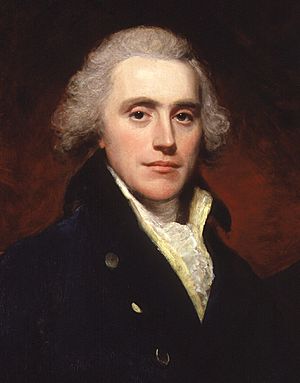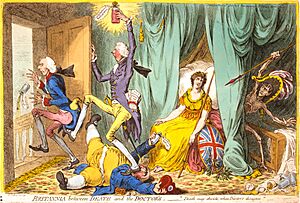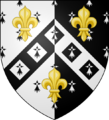Henry Addington facts for kids
Quick facts for kids
The Viscount Sidmouth
|
|
|---|---|

Detail of painting by William Beechey
|
|
| Prime Minister of the United Kingdom Chancellor of the Exchequer |
|
| In office 17 March 1801 – 10 May 1804 |
|
| Monarch | George III |
| Preceded by | William Pitt the Younger |
| Succeeded by | William Pitt the Younger |
| Lord President of the Council | |
| In office 14 January – 10 July 1805 |
|
| Monarch | George III |
| Prime Minister | William Pitt the Younger |
| Preceded by | The Duke of Portland |
| Succeeded by | The Earl Camden |
| In office 8 October 1806 – 26 March 1807 |
|
| Prime Minister | Spencer Perceval |
| Preceded by | The Earl Fitzwilliam |
| Succeeded by | The Earl Camden |
| In office 8 April – 11 June 1812 |
|
| Prime Minister |
|
| Preceded by | The Earl Camden |
| Succeeded by | The Earl of Harrowby |
| Home Secretary | |
| In office 8 June 1812 – 17 January 1822 |
|
| Prime Minister | The Earl of Liverpool |
| Preceded by | Richard Ryder |
| Succeeded by | Robert Peel |
| Speaker of the House of Commons | |
| In office 8 June 1789 – 10 February 1801 |
|
| Preceded by | William Grenville |
| Succeeded by | Sir John Mitford |
| Member of Parliament for Devizes |
|
| In office 1784–1805 |
|
| Preceded by | Henry Jones |
| Succeeded by | Thomas Grimston Estcourt |
| Personal details | |
| Born | 30 May 1757 Holborn, Middlesex, England |
| Died | 15 February 1844 (aged 86) White Lodge, Surrey, England |
| Resting place | St Mary the Virgin, Mortlake |
| Political party | Tory (Addingtonian) |
| Spouses |
Ursula Hammond
(m. 1781; died 1811)Marianne Townsend
(m. 1823) |
| Children | 8 (by Hammond) |
| Parent | Anthony Addington (father) |
| Relatives |
|
| Education |
|
| Alma mater | Brasenose College, Oxford |
| Cabinet | Henry Addington § Notes |
| Signature | |
Henry Addington, 1st Viscount Sidmouth (born May 30, 1757 – died February 15, 1844) was an important British Tory politician. He served as the Prime Minister of the United Kingdom from 1801 to 1804.
Addington is best known for signing the Treaty of Amiens in 1802. This treaty brought a temporary peace with Napoleonic France during the French Revolutionary Wars. When the peace ended, he led Britain back into war. He also served for ten years as Home Secretary (from 1812 to 1822). In this role, he took strong actions against people who wanted big changes to the government. He was the longest-serving Home Secretary since the job was created in 1782.
Contents
Early Life and Family
Henry Addington was the son of Anthony Addington, who was a doctor to Pitt the Elder. His mother was Mary Addington. Because of his father's job, Henry was a childhood friend of William Pitt the Younger, who would also become Prime Minister.
Henry went to Reading School, Winchester College, and Brasenose College, Oxford. He then studied law. In 1781, he married Ursula Mary Hammond. They had eight children together. After Ursula died in 1811, Addington married Marianne Townsend in 1823.
Political Career
Henry Addington began his political journey in 1784. He was elected to the House of Commons to represent Devizes. In 1789, he became the Speaker of the House of Commons. This meant he was in charge of leading the debates and keeping order in Parliament.
Becoming Prime Minister
In March 1801, William Pitt the Younger resigned as Prime Minister. This happened because of disagreements with King George III over allowing more rights for Roman Catholics in Ireland. Pitt also faced challenges like poor health, difficulties in the war, and economic problems. Both Pitt and the King wanted Addington to become the new Prime Minister, even though Addington tried to get Pitt and the King to agree.
Leading the Country as Prime Minister
As Prime Minister, Addington focused a lot on foreign policy. Some historians have criticized his approach, but others argue he had a clear plan for Britain's place in Europe.
One of his big achievements was improving the income tax, making it twice as effective. In 1802, he signed the Treaty of Amiens. This treaty brought peace with Napoleon Bonaparte's France. Britain needed this peace because the country was struggling financially from the war and bad harvests.
By 1803, Britain was in a better position financially and diplomatically. Addington decided to declare war on France again when it became clear that France would not agree to a safe deal for Malta. This island was important for defending against a French invasion.
Addington was criticized for how he handled the war at first. However, Britain had few allies at the time, so focusing on defense was a smart move. He increased the size of the armed forces and made sure there was enough money to pay for the war. He also worked to build better relationships with countries like Russia, Austria, and Prussia. These relationships later led to the War of the Third Coalition after he left office. Addington also made Britain stronger against a possible French invasion by building Martello towers along the south coast and training over 600,000 men for defense.
Helping the Foundling Hospital
In 1802, Addington took on an honorary role at London's Foundling Hospital. This hospital cared for abandoned babies. He became a vice-president for life on its Court of Governors.
Why He Left Office

Even though the King supported Addington, it wasn't enough. Addington didn't have strong enough support from all members of Parliament. By May 1804, different political groups joined forces to replace his government. Addington struggled to keep a strong majority in Parliament. This, combined with his average public speaking skills, made him vulnerable to Pitt's strong leadership and powerful speeches. Pitt's attacks in Parliament weakened Addington's support, leading to his resignation.
Later Government Roles
Addington remained an important political figure because many Members of Parliament supported him. In December 1804, he made up with Pitt. Pitt then arranged for Addington to join the government as Lord President of the Council in January 1805. Pitt also wanted Addington to become a Lord so they wouldn't both be in the House of Commons. So, Addington became Viscount Sidmouth.
Addington later resigned from Pitt's government because Pitt broke a promise about a job for one of Addington's allies. In 1806, Addington became Lord Privy Seal in a new government called the "Ministry of All the Talents." He later returned to the role of Lord President until 1807. He resigned again because he disagreed with allowing more rights for Catholics, which King George III also opposed.
Serving as Home Secretary
Addington returned to government in March 1812 as Lord President. In June of the same year, he became Home Secretary. As Home Secretary, he was responsible for keeping law and order in Britain. This was a time of social unrest. He took strong measures, including temporarily stopping habeas corpus (a law that protects people from being held without charge) in 1817. He also helped pass the Six Acts in 1819, which aimed to prevent large public gatherings and control the press. His time as Home Secretary also saw the Peterloo Massacre in 1819, a tragic event where protesters were attacked by cavalry.
He left the Home Secretary role in 1822. However, he stayed in the government as a Minister without Portfolio for two more years. He continued to be active in the House of Lords, giving his last speech against Catholic Emancipation in 1829 and voting against the Reform Act 1832.
Homes and Legacy
Henry Addington had homes in Upottery, Devon, and Bulmershe Court near Reading. When he became Prime Minister, he moved to White Lodge in Richmond Park.
He remained connected to the Reading area. He led the Woodley Yeomanry Cavalry and was High Steward of Reading. He also gave four acres of land to Reading, which is now the site of the Royal Berkshire Hospital. Streets in Reading and Devizes are named after him, like Sidmouth Street and Addington Road.
As Speaker of the House of Commons, he also had a home within the Palace of Westminster from 1795.
Death
Henry Addington died in London on February 15, 1844, at the age of 86. He was buried in the churchyard at St Mary the Virgin, Mortlake, which is now part of Greater London.
Cabinet
Images for kids
See also
 In Spanish: Henry Addington para niños
In Spanish: Henry Addington para niños



